Cystic Fibrosis: Nursing Care Plan for Respiratory Patients
VerifiedAdded on 2022/09/14
|8
|1255
|12
Presentation
AI Summary
This presentation provides a comprehensive nursing care plan for patients with Cystic Fibrosis (CF), an inherited disease primarily affecting the lungs and digestive system. It begins with an overview of CF, including its pathophysiology, which involves the secretion of thick, sticky mucus leading to airway obstruction and potential infections. The presentation details the impact of CF on patients and their families, considering factors like infertility and malnutrition. It then outlines a thorough nursing assessment, including family medical history, physical condition, respiratory status, and activity tolerance. The core of the presentation focuses on nursing diagnoses, such as ineffective airway clearance and risk of infection, followed by a detailed care plan. This includes interventions like oxygen therapy, patient positioning, and emotional support. The presentation concludes with an evaluation of the care provided, highlighting improvements in respiratory distress, oxygenation, and infection control. The presentation is supported by relevant references and is designed to assist in understanding the critical aspects of CF patient care.
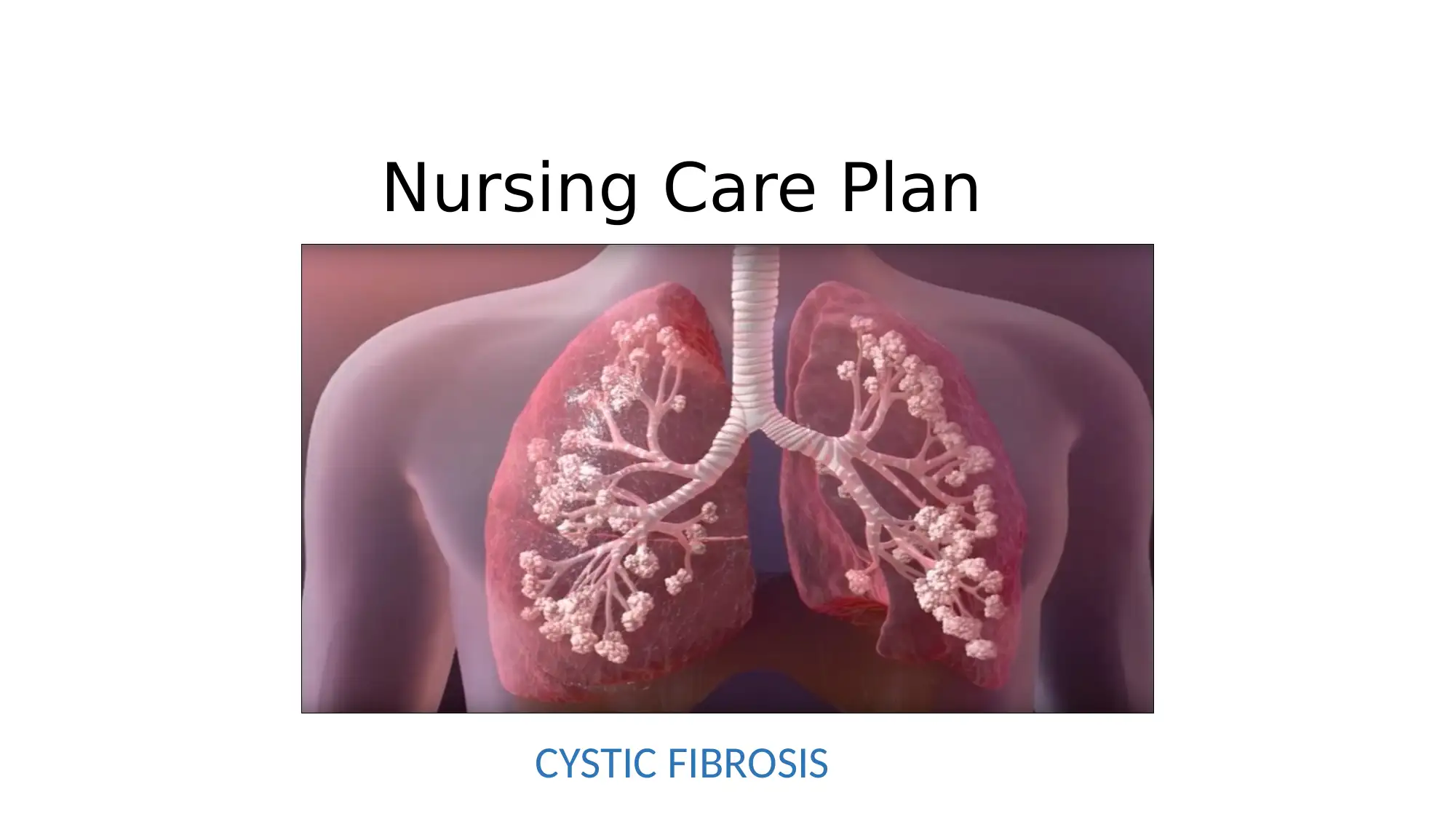
Nursing Care Plan
CYSTIC FIBROSIS
CYSTIC FIBROSIS
Paraphrase This Document
Need a fresh take? Get an instant paraphrase of this document with our AI Paraphraser
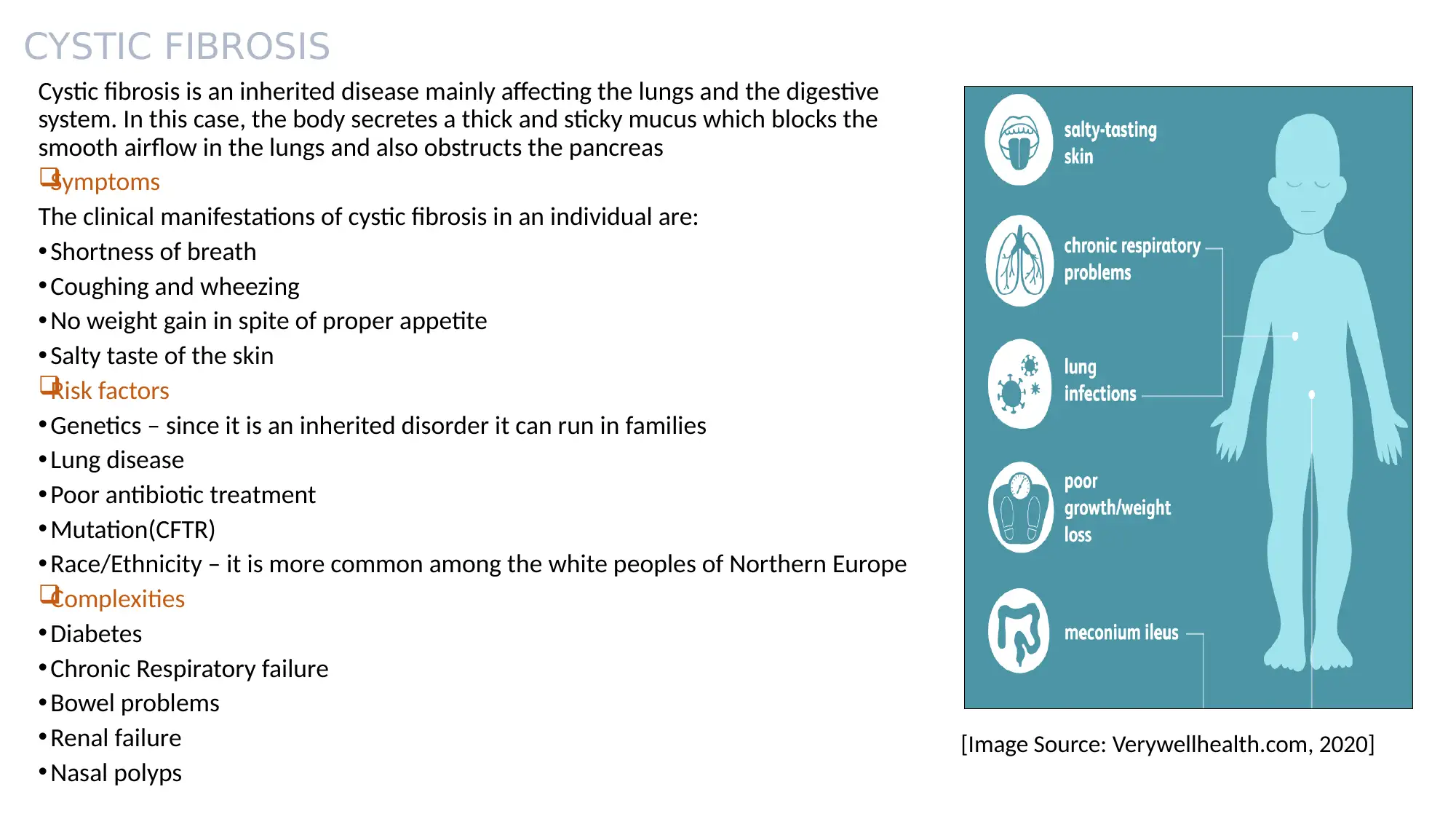
CYSTIC FIBROSIS
Cystic fibrosis is an inherited disease mainly affecting the lungs and the digestive
system. In this case, the body secretes a thick and sticky mucus which blocks the
smooth airflow in the lungs and also obstructs the pancreas
Symptoms
The clinical manifestations of cystic fibrosis in an individual are:
• Shortness of breath
• Coughing and wheezing
• No weight gain in spite of proper appetite
• Salty taste of the skin
Risk factors
• Genetics – since it is an inherited disorder it can run in families
• Lung disease
• Poor antibiotic treatment
• Mutation(CFTR)
• Race/Ethnicity – it is more common among the white peoples of Northern Europe
Complexities
• Diabetes
• Chronic Respiratory failure
• Bowel problems
• Renal failure
• Nasal polyps
[Image Source: Verywellhealth.com, 2020]
Cystic fibrosis is an inherited disease mainly affecting the lungs and the digestive
system. In this case, the body secretes a thick and sticky mucus which blocks the
smooth airflow in the lungs and also obstructs the pancreas
Symptoms
The clinical manifestations of cystic fibrosis in an individual are:
• Shortness of breath
• Coughing and wheezing
• No weight gain in spite of proper appetite
• Salty taste of the skin
Risk factors
• Genetics – since it is an inherited disorder it can run in families
• Lung disease
• Poor antibiotic treatment
• Mutation(CFTR)
• Race/Ethnicity – it is more common among the white peoples of Northern Europe
Complexities
• Diabetes
• Chronic Respiratory failure
• Bowel problems
• Renal failure
• Nasal polyps
[Image Source: Verywellhealth.com, 2020]
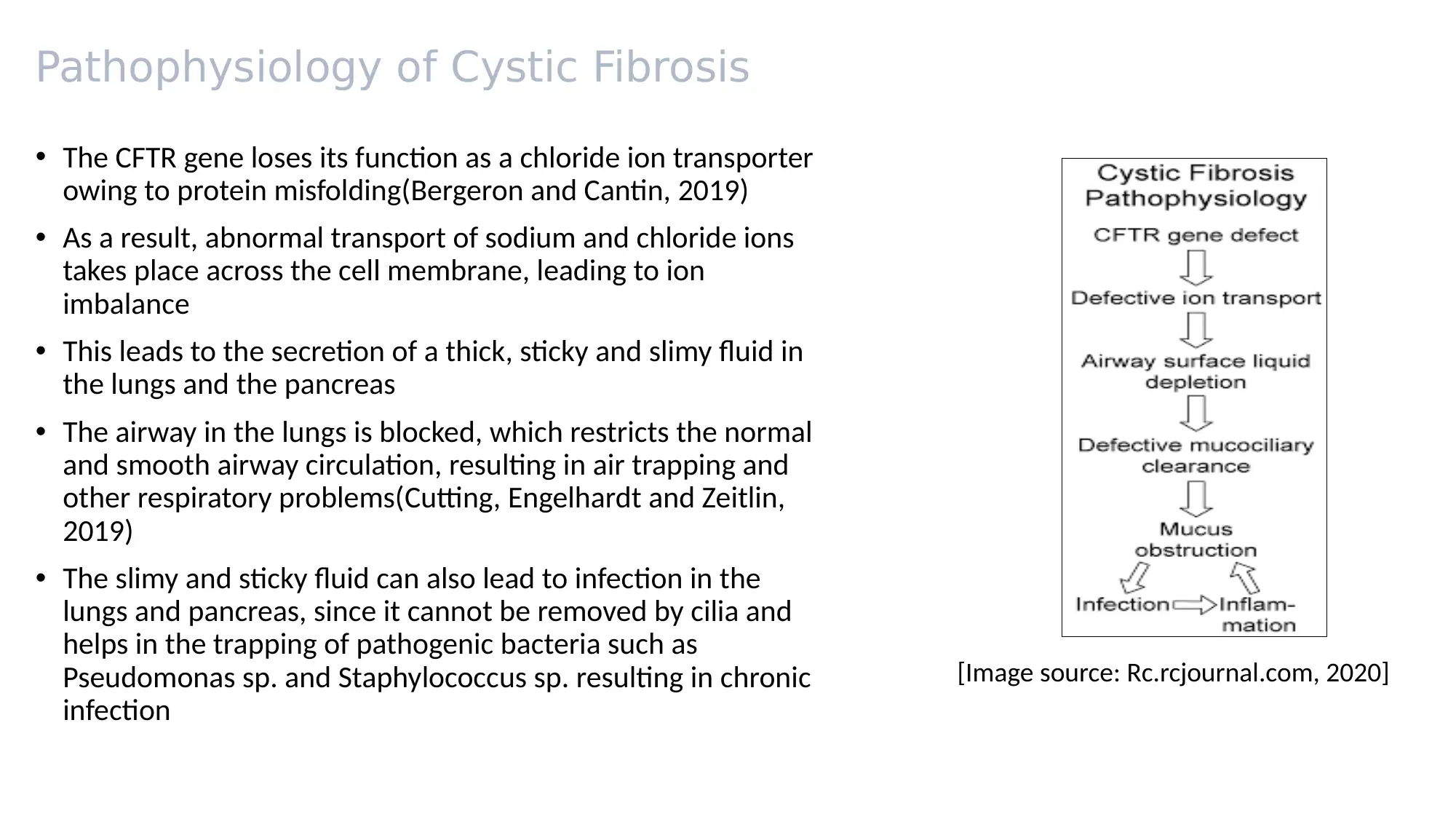
Pathophysiology of Cystic Fibrosis
• The CFTR gene loses its function as a chloride ion transporter
owing to protein misfolding(Bergeron and Cantin, 2019)
• As a result, abnormal transport of sodium and chloride ions
takes place across the cell membrane, leading to ion
imbalance
• This leads to the secretion of a thick, sticky and slimy fluid in
the lungs and the pancreas
• The airway in the lungs is blocked, which restricts the normal
and smooth airway circulation, resulting in air trapping and
other respiratory problems(Cutting, Engelhardt and Zeitlin,
2019)
• The slimy and sticky fluid can also lead to infection in the
lungs and pancreas, since it cannot be removed by cilia and
helps in the trapping of pathogenic bacteria such as
Pseudomonas sp. and Staphylococcus sp. resulting in chronic
infection
[Image source: Rc.rcjournal.com, 2020]
• The CFTR gene loses its function as a chloride ion transporter
owing to protein misfolding(Bergeron and Cantin, 2019)
• As a result, abnormal transport of sodium and chloride ions
takes place across the cell membrane, leading to ion
imbalance
• This leads to the secretion of a thick, sticky and slimy fluid in
the lungs and the pancreas
• The airway in the lungs is blocked, which restricts the normal
and smooth airway circulation, resulting in air trapping and
other respiratory problems(Cutting, Engelhardt and Zeitlin,
2019)
• The slimy and sticky fluid can also lead to infection in the
lungs and pancreas, since it cannot be removed by cilia and
helps in the trapping of pathogenic bacteria such as
Pseudomonas sp. and Staphylococcus sp. resulting in chronic
infection
[Image source: Rc.rcjournal.com, 2020]
⊘ This is a preview!⊘
Do you want full access?
Subscribe today to unlock all pages.

Trusted by 1+ million students worldwide
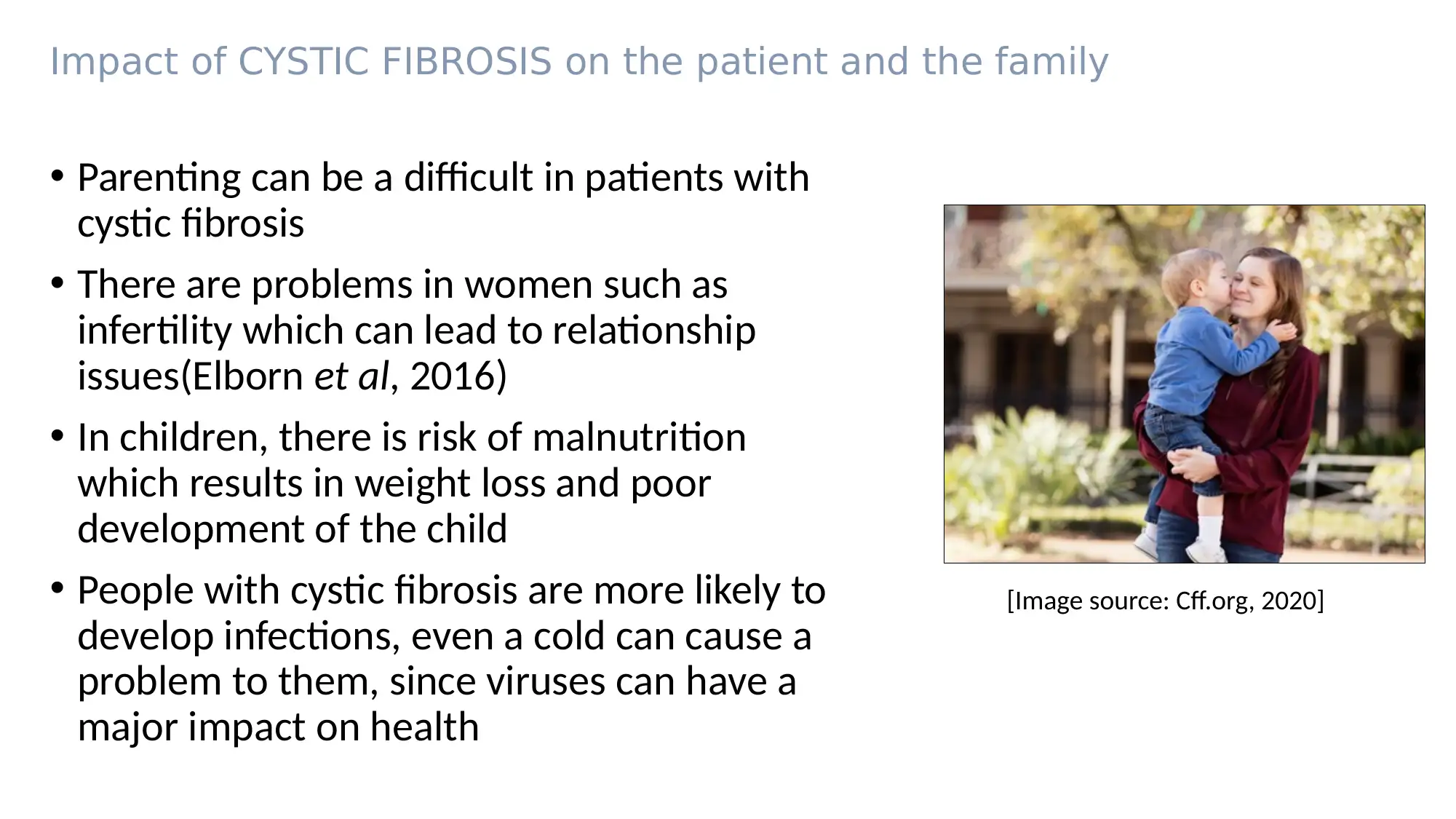
Impact of CYSTIC FIBROSIS on the patient and the family
• Parenting can be a difficult in patients with
cystic fibrosis
• There are problems in women such as
infertility which can lead to relationship
issues(Elborn et al, 2016)
• In children, there is risk of malnutrition
which results in weight loss and poor
development of the child
• People with cystic fibrosis are more likely to
develop infections, even a cold can cause a
problem to them, since viruses can have a
major impact on health
[Image source: Cff.org, 2020]
• Parenting can be a difficult in patients with
cystic fibrosis
• There are problems in women such as
infertility which can lead to relationship
issues(Elborn et al, 2016)
• In children, there is risk of malnutrition
which results in weight loss and poor
development of the child
• People with cystic fibrosis are more likely to
develop infections, even a cold can cause a
problem to them, since viruses can have a
major impact on health
[Image source: Cff.org, 2020]
Paraphrase This Document
Need a fresh take? Get an instant paraphrase of this document with our AI Paraphraser
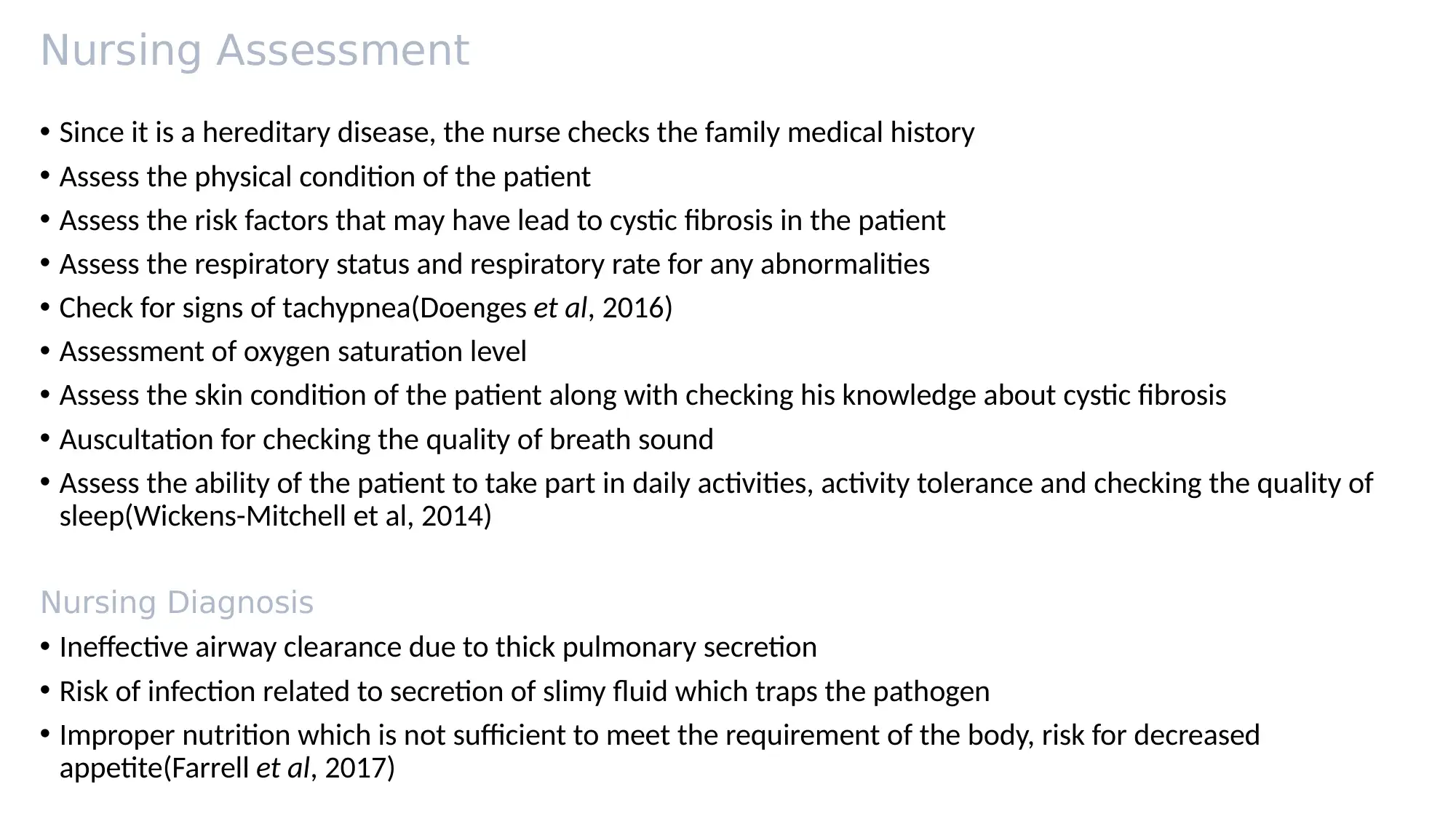
Nursing Assessment
• Since it is a hereditary disease, the nurse checks the family medical history
• Assess the physical condition of the patient
• Assess the risk factors that may have lead to cystic fibrosis in the patient
• Assess the respiratory status and respiratory rate for any abnormalities
• Check for signs of tachypnea(Doenges et al, 2016)
• Assessment of oxygen saturation level
• Assess the skin condition of the patient along with checking his knowledge about cystic fibrosis
• Auscultation for checking the quality of breath sound
• Assess the ability of the patient to take part in daily activities, activity tolerance and checking the quality of
sleep(Wickens-Mitchell et al, 2014)
Nursing Diagnosis
• Ineffective airway clearance due to thick pulmonary secretion
• Risk of infection related to secretion of slimy fluid which traps the pathogen
• Improper nutrition which is not sufficient to meet the requirement of the body, risk for decreased
appetite(Farrell et al, 2017)
• Since it is a hereditary disease, the nurse checks the family medical history
• Assess the physical condition of the patient
• Assess the risk factors that may have lead to cystic fibrosis in the patient
• Assess the respiratory status and respiratory rate for any abnormalities
• Check for signs of tachypnea(Doenges et al, 2016)
• Assessment of oxygen saturation level
• Assess the skin condition of the patient along with checking his knowledge about cystic fibrosis
• Auscultation for checking the quality of breath sound
• Assess the ability of the patient to take part in daily activities, activity tolerance and checking the quality of
sleep(Wickens-Mitchell et al, 2014)
Nursing Diagnosis
• Ineffective airway clearance due to thick pulmonary secretion
• Risk of infection related to secretion of slimy fluid which traps the pathogen
• Improper nutrition which is not sufficient to meet the requirement of the body, risk for decreased
appetite(Farrell et al, 2017)
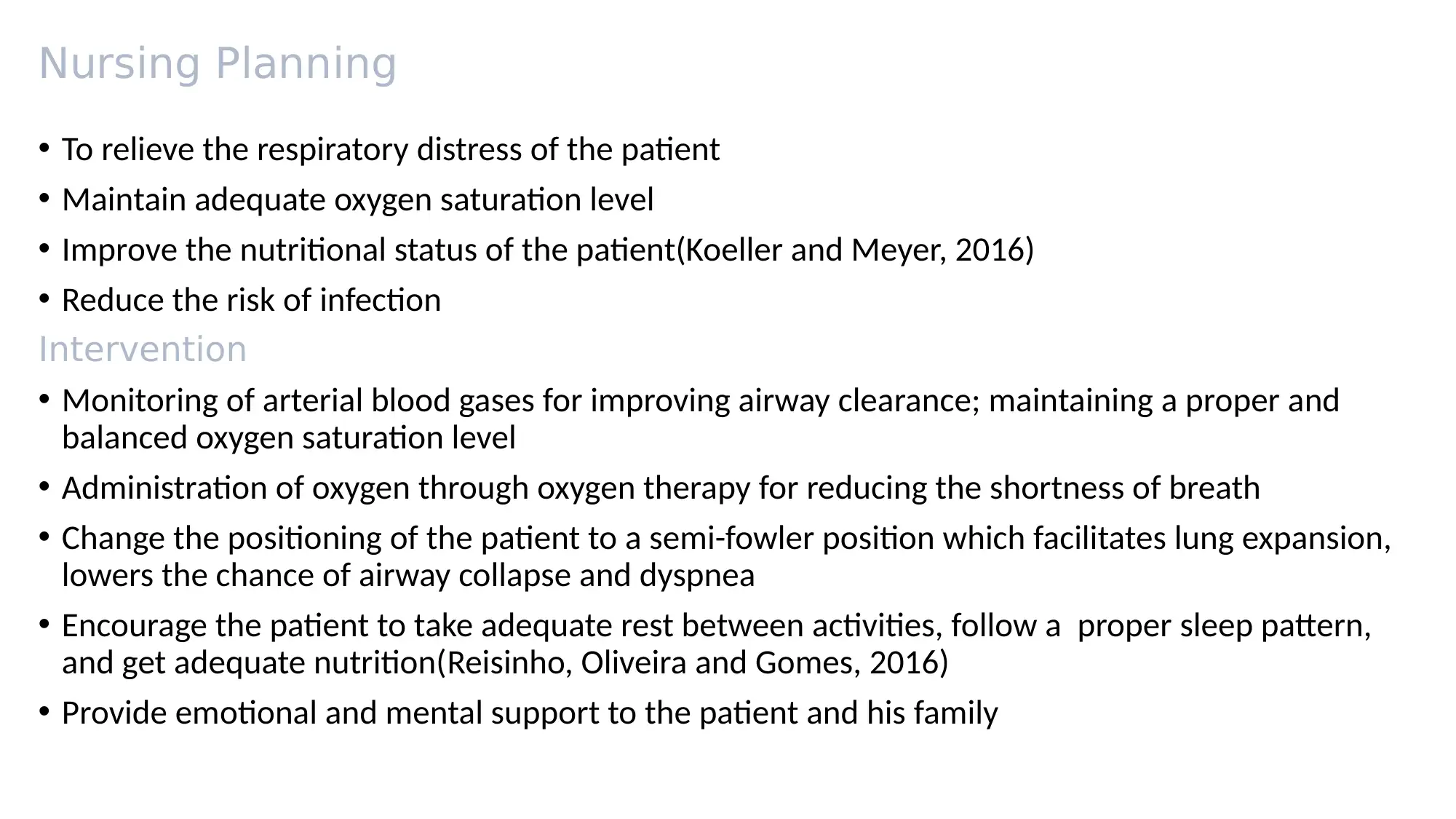
Nursing Planning
• To relieve the respiratory distress of the patient
• Maintain adequate oxygen saturation level
• Improve the nutritional status of the patient(Koeller and Meyer, 2016)
• Reduce the risk of infection
Intervention
• Monitoring of arterial blood gases for improving airway clearance; maintaining a proper and
balanced oxygen saturation level
• Administration of oxygen through oxygen therapy for reducing the shortness of breath
• Change the positioning of the patient to a semi-fowler position which facilitates lung expansion,
lowers the chance of airway collapse and dyspnea
• Encourage the patient to take adequate rest between activities, follow a proper sleep pattern,
and get adequate nutrition(Reisinho, Oliveira and Gomes, 2016)
• Provide emotional and mental support to the patient and his family
• To relieve the respiratory distress of the patient
• Maintain adequate oxygen saturation level
• Improve the nutritional status of the patient(Koeller and Meyer, 2016)
• Reduce the risk of infection
Intervention
• Monitoring of arterial blood gases for improving airway clearance; maintaining a proper and
balanced oxygen saturation level
• Administration of oxygen through oxygen therapy for reducing the shortness of breath
• Change the positioning of the patient to a semi-fowler position which facilitates lung expansion,
lowers the chance of airway collapse and dyspnea
• Encourage the patient to take adequate rest between activities, follow a proper sleep pattern,
and get adequate nutrition(Reisinho, Oliveira and Gomes, 2016)
• Provide emotional and mental support to the patient and his family
⊘ This is a preview!⊘
Do you want full access?
Subscribe today to unlock all pages.

Trusted by 1+ million students worldwide
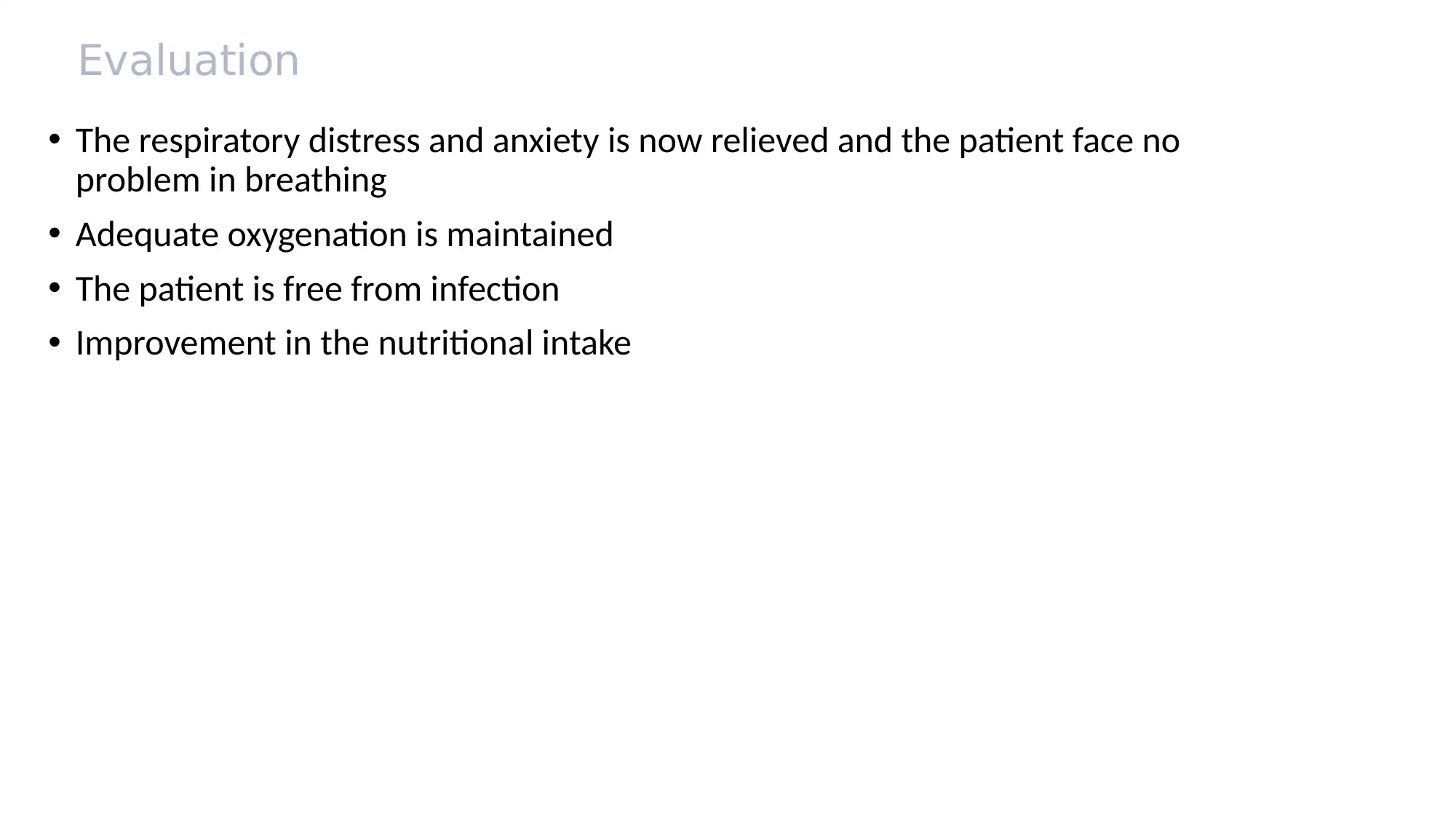
Evaluation
• The respiratory distress and anxiety is now relieved and the patient face no
problem in breathing
• Adequate oxygenation is maintained
• The patient is free from infection
• Improvement in the nutritional intake
• The respiratory distress and anxiety is now relieved and the patient face no
problem in breathing
• Adequate oxygenation is maintained
• The patient is free from infection
• Improvement in the nutritional intake
Paraphrase This Document
Need a fresh take? Get an instant paraphrase of this document with our AI Paraphraser
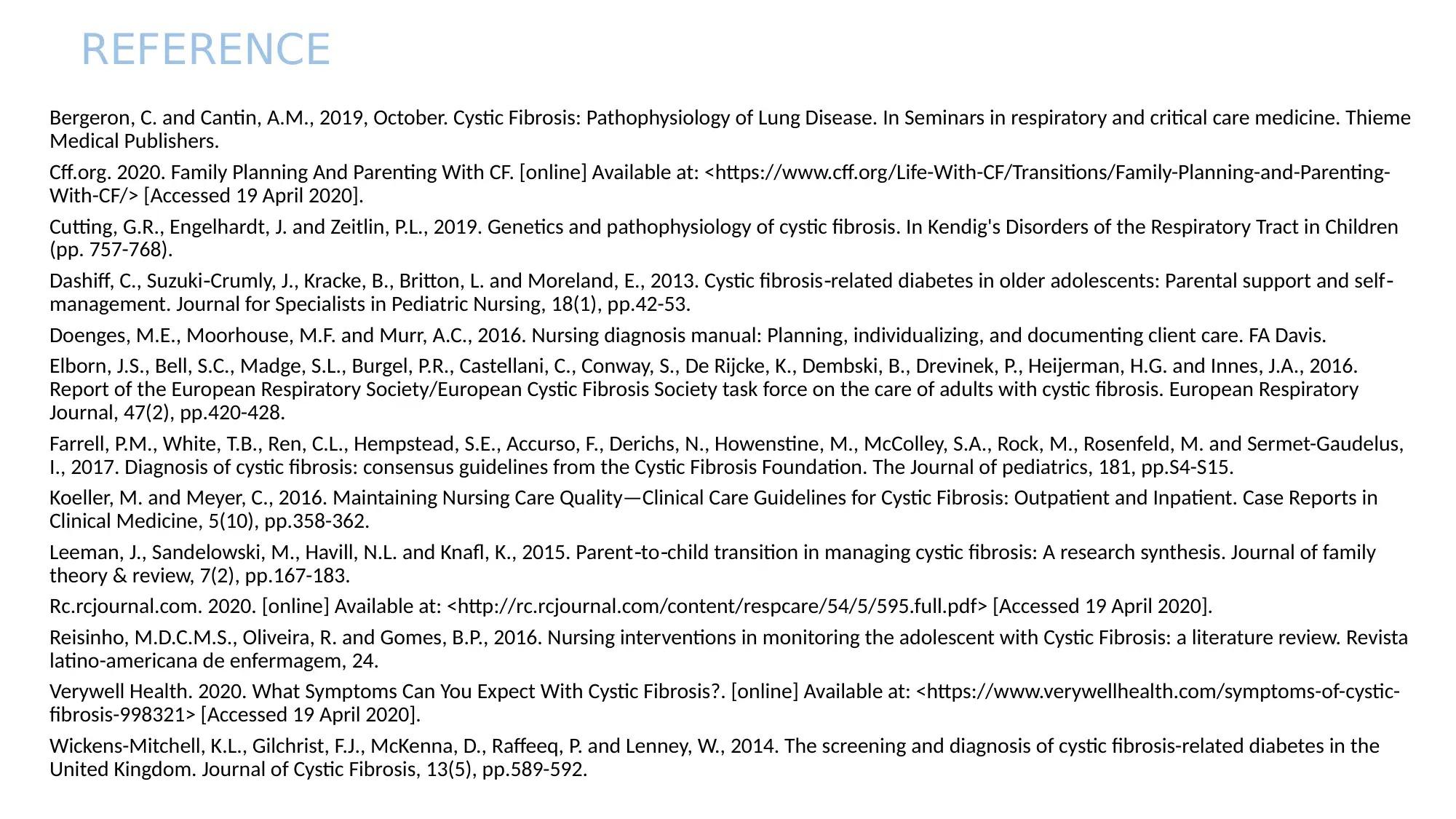
REFERENCE
Bergeron, C. and Cantin, A.M., 2019, October. Cystic Fibrosis: Pathophysiology of Lung Disease. In Seminars in respiratory and critical care medicine. Thieme
Medical Publishers.
Cff.org. 2020. Family Planning And Parenting With CF. [online] Available at: <https://www.cff.org/Life-With-CF/Transitions/Family-Planning-and-Parenting-
With-CF/> [Accessed 19 April 2020].
Cutting, G.R., Engelhardt, J. and Zeitlin, P.L., 2019. Genetics and pathophysiology of cystic fibrosis. In Kendig's Disorders of the Respiratory Tract in Children
(pp. 757-768).
Dashiff, C., Suzuki Crumly, J., Kracke, B., Britton, L. and Moreland, E., 2013. Cystic fibrosis related diabetes in older adolescents: Parental support and self‐ ‐ ‐
management. Journal for Specialists in Pediatric Nursing, 18(1), pp.42-53.
Doenges, M.E., Moorhouse, M.F. and Murr, A.C., 2016. Nursing diagnosis manual: Planning, individualizing, and documenting client care. FA Davis.
Elborn, J.S., Bell, S.C., Madge, S.L., Burgel, P.R., Castellani, C., Conway, S., De Rijcke, K., Dembski, B., Drevinek, P., Heijerman, H.G. and Innes, J.A., 2016.
Report of the European Respiratory Society/European Cystic Fibrosis Society task force on the care of adults with cystic fibrosis. European Respiratory
Journal, 47(2), pp.420-428.
Farrell, P.M., White, T.B., Ren, C.L., Hempstead, S.E., Accurso, F., Derichs, N., Howenstine, M., McColley, S.A., Rock, M., Rosenfeld, M. and Sermet-Gaudelus,
I., 2017. Diagnosis of cystic fibrosis: consensus guidelines from the Cystic Fibrosis Foundation. The Journal of pediatrics, 181, pp.S4-S15.
Koeller, M. and Meyer, C., 2016. Maintaining Nursing Care Quality—Clinical Care Guidelines for Cystic Fibrosis: Outpatient and Inpatient. Case Reports in
Clinical Medicine, 5(10), pp.358-362.
Leeman, J., Sandelowski, M., Havill, N.L. and Knafl, K., 2015. Parent to child transition in managing cystic fibrosis: A research synthesis. Journal of family‐ ‐
theory & review, 7(2), pp.167-183.
Rc.rcjournal.com. 2020. [online] Available at: <http://rc.rcjournal.com/content/respcare/54/5/595.full.pdf> [Accessed 19 April 2020].
Reisinho, M.D.C.M.S., Oliveira, R. and Gomes, B.P., 2016. Nursing interventions in monitoring the adolescent with Cystic Fibrosis: a literature review. Revista
latino-americana de enfermagem, 24.
Verywell Health. 2020. What Symptoms Can You Expect With Cystic Fibrosis?. [online] Available at: <https://www.verywellhealth.com/symptoms-of-cystic-
fibrosis-998321> [Accessed 19 April 2020].
Wickens-Mitchell, K.L., Gilchrist, F.J., McKenna, D., Raffeeq, P. and Lenney, W., 2014. The screening and diagnosis of cystic fibrosis-related diabetes in the
United Kingdom. Journal of Cystic Fibrosis, 13(5), pp.589-592.
Bergeron, C. and Cantin, A.M., 2019, October. Cystic Fibrosis: Pathophysiology of Lung Disease. In Seminars in respiratory and critical care medicine. Thieme
Medical Publishers.
Cff.org. 2020. Family Planning And Parenting With CF. [online] Available at: <https://www.cff.org/Life-With-CF/Transitions/Family-Planning-and-Parenting-
With-CF/> [Accessed 19 April 2020].
Cutting, G.R., Engelhardt, J. and Zeitlin, P.L., 2019. Genetics and pathophysiology of cystic fibrosis. In Kendig's Disorders of the Respiratory Tract in Children
(pp. 757-768).
Dashiff, C., Suzuki Crumly, J., Kracke, B., Britton, L. and Moreland, E., 2013. Cystic fibrosis related diabetes in older adolescents: Parental support and self‐ ‐ ‐
management. Journal for Specialists in Pediatric Nursing, 18(1), pp.42-53.
Doenges, M.E., Moorhouse, M.F. and Murr, A.C., 2016. Nursing diagnosis manual: Planning, individualizing, and documenting client care. FA Davis.
Elborn, J.S., Bell, S.C., Madge, S.L., Burgel, P.R., Castellani, C., Conway, S., De Rijcke, K., Dembski, B., Drevinek, P., Heijerman, H.G. and Innes, J.A., 2016.
Report of the European Respiratory Society/European Cystic Fibrosis Society task force on the care of adults with cystic fibrosis. European Respiratory
Journal, 47(2), pp.420-428.
Farrell, P.M., White, T.B., Ren, C.L., Hempstead, S.E., Accurso, F., Derichs, N., Howenstine, M., McColley, S.A., Rock, M., Rosenfeld, M. and Sermet-Gaudelus,
I., 2017. Diagnosis of cystic fibrosis: consensus guidelines from the Cystic Fibrosis Foundation. The Journal of pediatrics, 181, pp.S4-S15.
Koeller, M. and Meyer, C., 2016. Maintaining Nursing Care Quality—Clinical Care Guidelines for Cystic Fibrosis: Outpatient and Inpatient. Case Reports in
Clinical Medicine, 5(10), pp.358-362.
Leeman, J., Sandelowski, M., Havill, N.L. and Knafl, K., 2015. Parent to child transition in managing cystic fibrosis: A research synthesis. Journal of family‐ ‐
theory & review, 7(2), pp.167-183.
Rc.rcjournal.com. 2020. [online] Available at: <http://rc.rcjournal.com/content/respcare/54/5/595.full.pdf> [Accessed 19 April 2020].
Reisinho, M.D.C.M.S., Oliveira, R. and Gomes, B.P., 2016. Nursing interventions in monitoring the adolescent with Cystic Fibrosis: a literature review. Revista
latino-americana de enfermagem, 24.
Verywell Health. 2020. What Symptoms Can You Expect With Cystic Fibrosis?. [online] Available at: <https://www.verywellhealth.com/symptoms-of-cystic-
fibrosis-998321> [Accessed 19 April 2020].
Wickens-Mitchell, K.L., Gilchrist, F.J., McKenna, D., Raffeeq, P. and Lenney, W., 2014. The screening and diagnosis of cystic fibrosis-related diabetes in the
United Kingdom. Journal of Cystic Fibrosis, 13(5), pp.589-592.
1 out of 8
Related Documents
Your All-in-One AI-Powered Toolkit for Academic Success.
+13062052269
info@desklib.com
Available 24*7 on WhatsApp / Email
![[object Object]](/_next/static/media/star-bottom.7253800d.svg)
Unlock your academic potential
Copyright © 2020–2025 A2Z Services. All Rights Reserved. Developed and managed by ZUCOL.





